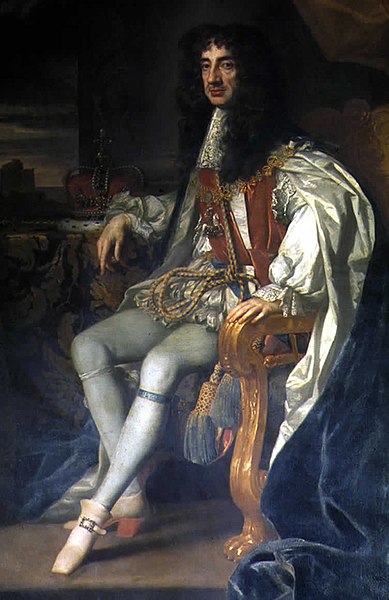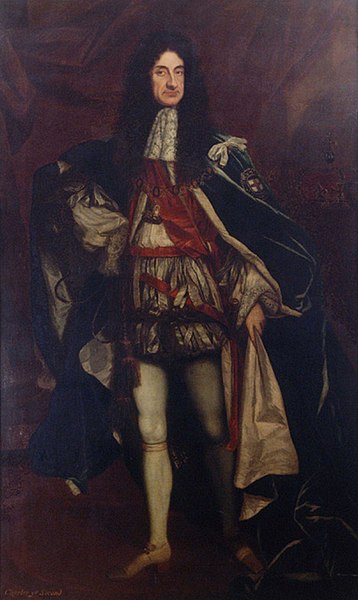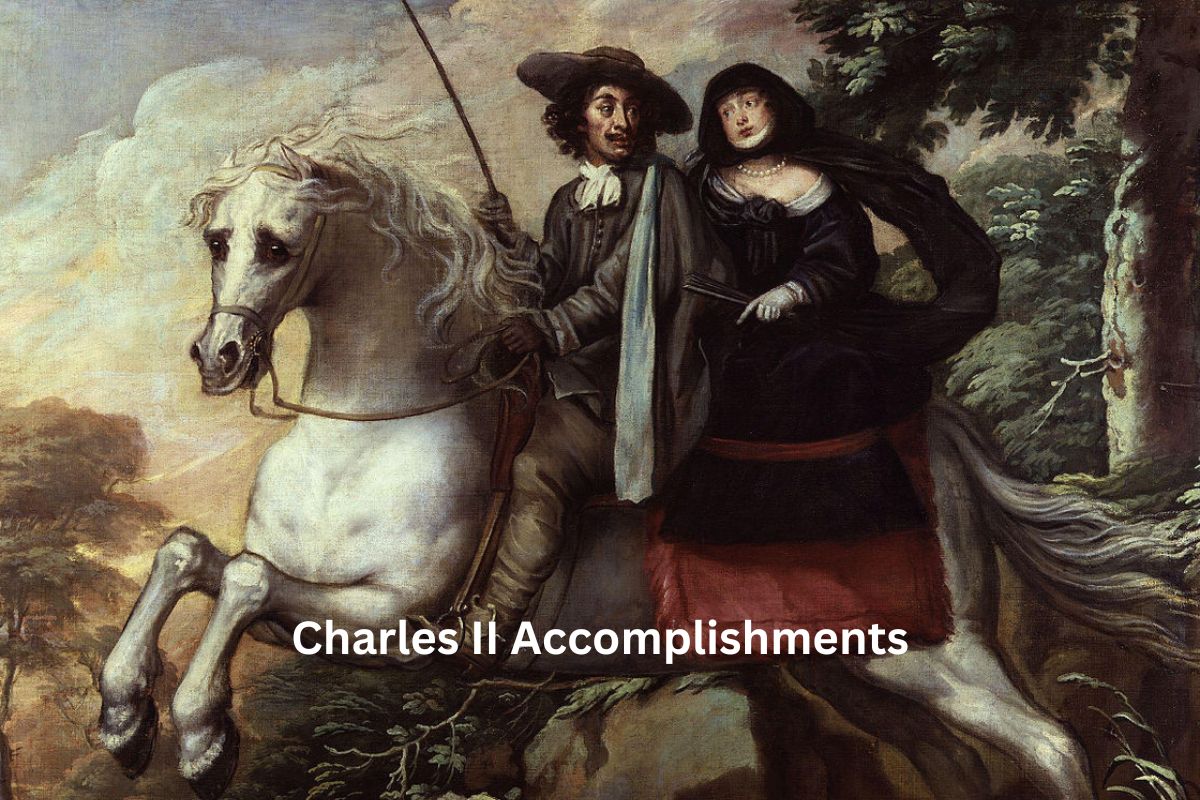Born on May 29, 1630, Charles II, the son of King Charles I and Queen Henrietta Maria, ascended to the throne in 1660, marking the Restoration of the monarchy following the tumultuous English Civil War and Interregnum.
His reign brought political stability and cultural vibrancy, exemplified by his efforts to rebuild London after the Great Fire of 1666.
Internationally, Charles II engaged in politics through the Treaty of Dover with France, impacting England’s foreign policy.
He also fostered scientific inquiry by establishing the Royal Society. However, his reign introduced the Clarendon Code, strengthening the Anglican Church while suppressing religious dissent.
Charles II passed away on February 6, 1685, succeeded by his brother, King James II, leaving a lasting impact on the restoration of monarchy and a culturally rich era in late 17th-century England.
Accomplishments of Charles II
1. Restoration of the monarchy in England
Charles II’s reign began in 1660, marking the end of the English Interregnum, which followed the execution of his father, King Charles I, during the English Civil War.
Also Read: Facts About Charles II
His return to England was a significant event and symbolized the reinstatement of the monarchy, bringing stability after years of political turmoil.

2. Passage of the Restoration Settlement
The Restoration Settlement was a series of political and legal measures aimed at reestablishing order and stability in England after the upheaval of the Civil War and the Commonwealth.
It included the Declaration of Breda in 1660, where Charles II outlined his terms for becoming king, which included promises of amnesty and religious tolerance.
Also Read: King James Facts
The Indemnity and Oblivion Act of 1660 granted a pardon to most people who had supported the Parliamentarian side during the Civil War, promoting reconciliation.
However, some prominent regicides (those responsible for Charles I’s execution) were exempt from these pardons and faced punishment.
3. End of the Protectorate and Cromwellian rule
The Protectorate was the period of government under Oliver Cromwell after the Civil War, following the execution of Charles I.
Charles II’s return to the throne marked the end of the Protectorate, as well as the rule of the Cromwellian regime.
Cromwell’s death in 1658 and the subsequent lack of a strong leader led to political instability, contributing to the invitation for Charles II to return and restore the monarchy.
4. Implementation of the Clarendon Code to support the Anglican Church
The Clarendon Code refers to a set of laws and measures introduced during the reign of Charles II to restore and uphold the supremacy of the Anglican Church (Church of England) and to suppress religious dissent.
The Corporation Act of 1661 required all officeholders to take Anglican communion and renounce the Covenant, effectively excluding non-Anglicans from public office.
The Act of Uniformity of 1662 mandated the use of the Book of Common Prayer in Anglican church services, leading to the ejection of dissenting clergy from their positions.
The Conventicle Act of 1664 prohibited religious assemblies of more than five people outside the Church of England, aiming to curtail non-conformist worship.
5. Signing of the Treaty of Dover with France
In 1670, Charles II signed the Treaty of Dover with his cousin, King Louis XIV of France.
This secret treaty had several key provisions, including a commitment by Charles II to convert to Catholicism in exchange for financial and military support from France.
The treaty also stipulated that England would join France in a war against the Dutch Republic (the Third Anglo-Dutch War), which had significant implications for European politics and warfare at the time.
Charles’s alignment with France was controversial in England and contributed to political tensions during his reign.
6. Establishment of the Royal Society to promote science
Charles II played a pivotal role in the establishment of the Royal Society in 1660.
The Royal Society was founded as a scientific organization to promote and support scientific inquiry, experimentation, and the dissemination of knowledge.
Under the leadership of figures like Robert Boyle and Sir Isaac Newton, the Royal Society made significant contributions to the advancement of scientific understanding during the 17th century.
Charles II’s support for the Royal Society reflects his interest in the progress of science and innovation during his reign.
7. Rebuilding of London after the Great Fire of 1666
The Great Fire of London, which occurred in September 1666, was a devastating event that resulted in the destruction of a large part of the city, including many buildings and homes.
Charles II played a significant role in the city’s recovery efforts. He established a commission to oversee the rebuilding process, headed by Sir Christopher Wren, one of the most renowned architects of the time.
The reconstruction of London led to the creation of a more modern and organized city, with the introduction of wide streets and fire-resistant buildings, which had a lasting impact on the city’s layout and architecture.

8. Promotion of the Navigation Acts for trade and naval power
Charles II supported and enforced the Navigation Acts, a series of laws passed in the 1660s and 1670s aimed at boosting England’s commercial and naval power.
These acts required that certain goods be transported on English ships, thereby promoting English shipping and seafaring. They also restricted colonial trade with other nations, ensuring that most colonial exports went directly to England.
The Navigation Acts were part of a broader strategy to bolster England’s economic and naval dominance, contributing to the growth of the British Empire.
9. Establishment of the Tangier Garrison in North Africa
In 1662, Charles II acquired the city of Tangier, located in modern-day Morocco, as part of his marriage dowry when he married Catherine of Braganza.
He established a garrison in Tangier to secure English interests in the Mediterranean and protect English shipping routes from piracy.
The Tangier Garrison was strategically important, serving as both a naval base and a trading post for English merchants in the Mediterranean and North Africa.
10. Patronage of the arts and cultural flourishing during his reign.
Charles II’s court was known for its patronage of the arts, fostering a vibrant cultural environment during the Restoration period.
Theatrical productions flourished, with the reopening of theaters that had been closed during the Commonwealth era. Playwrights like John Dryden and Sir George Etherege enjoyed royal favor.
The visual arts also thrived during this time, with artists like Sir Peter Lely and Sir Godfrey Kneller receiving commissions from the king to paint portraits.
Charles II’s support for culture and the arts helped create a period of creativity and innovation, often referred to as the “Restoration Comedy” and the “Restoration Court.”
